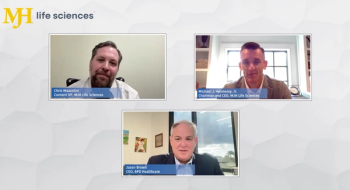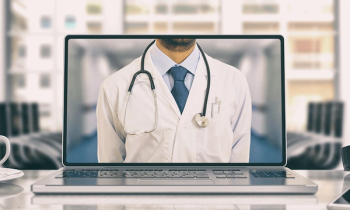
The Clinical Divide E02: A New Wearables Landscape & The Big Aspirin Question
Leaders in wearable tech are pushing for enterprise-level health system adoption, and much of what we know about aspirin has been turned on its head.
How can patients navigate the exploding wearables business? The answer: by working and partnering with doctors and healthcare systems. Are tried and true therapies always the best answer? Maybe not.
Hello and welcome to The Clinical Divide, the newest Healthcare Analytics News video series. I'm Dr. Kevin Campbell and I'm your host. I'm a Duke-trained cardiologist and the CEO of the healthcare data startup PaceMate.
Every week I look at the hottest health tech stories and provide insights that healthcare leaders and clinicians can really use to work together and grow. Ultimately we can help patients and improve outcomes. It's all about bridging The Clinical Divide.
A New Wearables Landscape
Now let's get to our first story today. There was big news in the last week by both Apple Watch and Fitbit. Lately we've seen some announcements by both companies. First, Apple released its latest model smartwatch. The Apple Watch Series 4 is all about health. It has a built-in fall detection system which can be incredibly helpful in the elderly.
That's pretty exciting, but the most promising feature is its ECG reader. This'll help users monitor their heart activity in real time with a real electrocardiogram. Both new features have the potential to engage patients in their own healthcare, which, as we know, is vital to improving health outcomes.
Then we saw Fitbit, in about the same time period, unveil a new digital platform that they call Fitbit Care. It's for enterprises like healthcare systems, insurers and employers, and it uses digital health interventions and health coaching in an attempt to drive behavior change. Again, it's another way to engage patients in their own healthcare, which we know from previous studies can help improve outcomes.
These two digital health solutions from both Apple and Fitbit are among others that are out there, and they have great promise, but they also can pose great challenges. As the mhealth market heats up and the FDA approves more cutting edge technologies, how can we know which devices to use? Which ones are worth using? Which technologies transmit reliable information to our patients? Which ones are "garbage in equals garbage out"?
As is true so often in healthcare, this uncertainty really requires clinicians and healthcare executives, and those in the c-suite, to collaborate. Administrators, as we know, most often control the money and the bulk purchasing any healthcare system has. There's a lot of negotiating and there's a lot of bottom lines that have to be met.
So it'll be ultimately up to the executives to decide whether a hospital uses something like Fitbit Care, or engages AliveCor for production of their device, or uses the Apple Watch. They need input from clinicians, because it's the doctors and clinicians who must test these technologies and determine how, if at all, they can enter the healthcare continuum and work their way in to existing workflows.
Both parties — both parties — must work together to map out a path for wearable adoption and mhealth apps to improve outcomes and reduce cost, which is important to all of us. Unless we join forces as clinicians and healthcare executives to work together to help determine the best devices for widespread use, it's going to be awfully hard for clinicians to guide patients in this brave new world.
The Big Aspirin Question
Now let's transition from high-tech to what I think is relatively low-tech and a common therapy: aspirin. Next up, we have an interesting new study that was published this week in the New England Journal of Medicine. In this study researchers found that low daily doses of aspirin might not help older, healthy people who do not have heart disease like we previously had been suspicious of.
Many elderly people are taking a baby aspirin a day as primary prevention, and now this study has turned that idea upside down. In fact, the study shows that this type of regimen could actually potentially cause harm. In the study there was no decrease of cardiac events for prophylactic aspirin therapy in healthy older adults, but the rates of gastrointestinal bleeding were much higher in those that were taking low dose aspirin.
So does it hurt or does it help? We're going to obviously need more research into this finding before we can draw conclusions that will really change our practice forever. But this study certainly offers us a highlight of an important concept that we should all stick with: Follow the data.
Follow the Data
Be willing to change. Be ready to evolve as both a clinician and a healthcare system when new evidence that's very reliable is presented. For clinicians, data can and should change how we practice. New insights can lead us and our patients down new roads of treatment towards more desirable outcomes.
Health systems need to understand this too. Those in the c-suite, these administrators, they must be willing to adapt based on the data and based on the numbers in cooperation with clinicians, regardless of how uncomfortable, or expensive in some cases, that change might be.
These c-suites and administrators need to provide the infrastructure in-house to allow doctors to obtain actionable insights on their direct patient populations. We need to be able to conduct research and this needs to be supported.
If we do this and work together to obtain the best technologies, change our practice when the data indicates it, and do research with the support of our non-clinician colleagues in the c-suite, even if we're in a private practice situation and not in an academic institution, good things are going to happen.
Interestingly, the patients are the ones that benefit the most. Sometimes the simplest therapies offer the greatest benefit, and sometimes we must realize that just because we've always done something one way doesn't mean that we should continue to do it the same way.
That goes for doctors, that also goes for c-suites and administrators. We have to evolve and grow together. If not, patients suffer.
For Healthcare Analytics News, I'm Dr. Kevin Campbell signing off for this week. See ya next time.
Get the best insights in healthcare analytics
Related:
The Clinical Divide E01: Civica Rx, 23andMe and a New Heart Failure Study






































